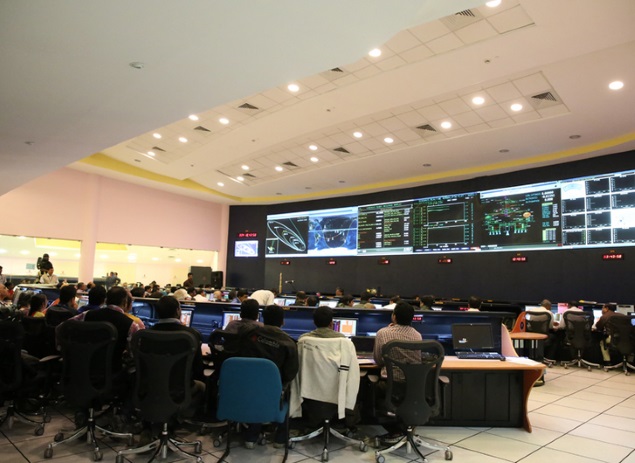- Home
- Science
- Science News
- US Spacecraft Enters Mars Orbit, Isro's Mangalyaan Next
US Spacecraft Enters Mars Orbit, Isro's Mangalyaan Next

The Indian spacecraft is due to slip into Martian orbit Tuesday night (Wednesday morning in India). It's India's first interplanetary mission, and no nation has been fully successful getting to the red planet on its first try. There have been more than three dozen attempts, and more than half of them have failed.
So U.S. scientists were relieved when Maven reached its destination after a 442 million mile (711 million kilometer) journey that began nearly a year ago. It joined three spacecraft, two American and one European, orbiting Mars.
"I think my heart's about ready to start again," Maven's chief investigator, Bruce Jakosky of the University of Colorado, said early Monday. "All I can say at this point is, 'We're in orbit at Mars, guys!'"
Now the real work begins for the $671 million mission, the first dedicated to studying the Martian upper atmosphere and the latest step in Nasa's bid to send astronauts to Mars in the 2030s.
Flight controllers in Colorado will spend the next six weeks adjusting Maven's altitude and checking its science instruments, and observing a comet streaking by at relatively close range. Then in early November, Maven will start probing the upper atmosphere of Mars. The spacecraft will conduct its observations from orbit; it's not meant to land.
Scientists believe the Martian atmosphere holds clues as to how Earth's neighbor went from being warm and wet billions of years ago to cold and dry. That early wet world may have harbored microbial life, a tantalizing question yet to be answered.
Jakosky, of University of Colorado's Laboratory for Atmospheric and Space Physics, hopes to learn where all the water on Mars went, along with the carbon dioxide that once comprised an atmosphere thick enough to hold moist clouds.
The gases may have been stripped away by the sun early in Mars' existence, escaping into the upper atmosphere and out into space. Maven's observations should be able to extrapolate back in time, he said.
Nasa launched Maven last November from Cape Canaveral, the 10th U.S. mission sent to orbit the red planet. Three earlier ones failed. Maven - short for Mars Atmosphere and Volatile Evolution Mission - will spend at least a year collecting data.
India's Mangalyaan probe was also launched that month, and Jakosky said Monday its arrival at Mars was eagerly awaited. India would become the fourth space program to reach Mars after the Soviet Union, the U.S. and Europe.
"We're hoping for their success," he said. "We're sending them the best wishes from the entire Maven team."
Indian officials have said the mission is chiefly a demonstration of technology. The spacecraft's instruments will gather data to help scientists study Martian weather systems and what happened to the ancient water. It will also look for methane, a key chemical in life processes on Earth that could also come from geological processes.
Maven, meanwhile, will have a rare brush with a comet next month.
The nucleus of newly discovered Comet Siding Spring will pass 82,000 miles (131,966 kilometers) from Mars on Oct. 19. The risk of comet dust damaging Maven is low, officials said, and the spacecraft should be able to observe Siding Spring as a science bonus.
Lockheed Martin Corp., Maven's maker, is operating the mission from its control center in Colorado.
Two Nasa rovers are on the Mars surface. Just this month, Curiosity rover arrived at its prime science target, a mountain named Sharp, ripe for drilling. The Opportunity rover is also still active a decade after landing.
More landers will be on the way in 2016 and 2018 from Nasa and the European and Russian space agencies. The next U.S. rover is scheduled for launch in 2020; it will collect samples for possible return to Earth, and attempt to produce oxygen from atmospheric carbon dioxide. That latter experiment, if successful, would allow future human explorers to live off the land, according to Nasa's John Grunsfeld, head of science missions and a former astronaut.
Catch the latest from the Consumer Electronics Show on Gadgets 360, at our CES 2026 hub.
Related Stories
- Samsung Galaxy Unpacked 2025
- ChatGPT
- Redmi Note 14 Pro+
- iPhone 16
- Apple Vision Pro
- Oneplus 12
- OnePlus Nord CE 3 Lite 5G
- iPhone 13
- Xiaomi 14 Pro
- Oppo Find N3
- Tecno Spark Go (2023)
- Realme V30
- Best Phones Under 25000
- Samsung Galaxy S24 Series
- Cryptocurrency
- iQoo 12
- Samsung Galaxy S24 Ultra
- Giottus
- Samsung Galaxy Z Flip 5
- Apple 'Scary Fast'
- Housefull 5
- GoPro Hero 12 Black Review
- Invincible Season 2
- JioGlass
- HD Ready TV
- Laptop Under 50000
- Smartwatch Under 10000
- Latest Mobile Phones
- Compare Phones
- OPPO Reno 15 Pro Max
- Honor Win RT
- Honor Win
- Xiaomi 17 Ultra Leica Edition
- Xiaomi 17 Ultra
- Huawei Nova 15
- Huawei Nova 15 Pro
- Huawei Nova 15 Ultra
- Asus ProArt P16
- MacBook Pro 14-inch (M5, 2025)
- OPPO Pad Air 5
- Huawei MatePad 11.5 (2026)
- Xiaomi Watch 5
- Huawei Watch 10th Anniversary Edition
- Acerpure Nitro Z Series 100-inch QLED TV
- Samsung 43 Inch LED Ultra HD (4K) Smart TV (UA43UE81AFULXL)
- Asus ROG Ally
- Nintendo Switch Lite
- Haier 1.6 Ton 5 Star Inverter Split AC (HSU19G-MZAID5BN-INV)
- Haier 1.6 Ton 5 Star Inverter Split AC (HSU19G-MZAIM5BN-INV)

















